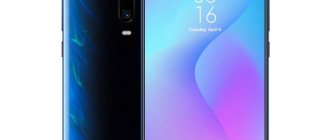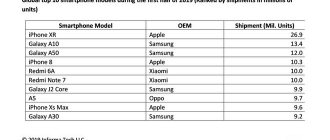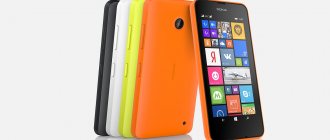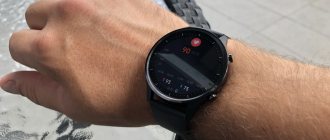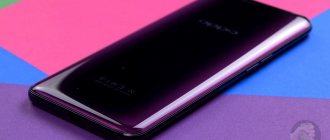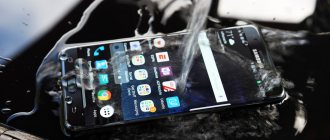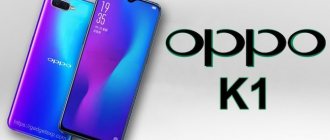Display
Oppo F7 is made for exactly one thing - to compete with the iPhone X. The latter has exactly the same cutout for the front camera and the screen is also frameless.
I have mixed feelings about the Oppo F7's screen. The crow inside me, which likes everything fashionable, beautiful and shiny, is delighted with the display of the seven. It has really thin frames on all three sides, a large and comfortable screen that can fit almost the entire Internet.
- 88% frontal surface
- diagonal 6.23 inches
- resolution 2280 x 1080 pixels
- pixel density 405 dpi
But the geek inside me, spoiled by modern technology, is cringing and grumbling about the similarity in appearance of the F7 and the tenth iPhone. As a lover of cool and innovative things, I want each company to follow its own unique path. She created devices that were noticeably different from each other. There was a time (the mid-2000s) when the imagination of Nokia and Siemens engineers produced such gems, the mere appearance of which caused, to put it mildly, bewilderment.
On the other hand, it's not so bad. Here's a real situation in which Oppo F7 is on top.
A character comes to the store who has no idea about all sorts of OnePlus 5T, Xiaomi Mi MIX 2S and, even more so, Nubia Red Magic. He sees an iPhone X on the shelf for a lot, a lot of money. Next to it is Oppo F7 for 23 thousand rubles. The latter looks the same as the tenth iPhone, only it costs several times less. And of course, the user buys Oppo F7 without mortgaging a house or apartment in order to take out a loan for iPhone X.
Design
The appearance of Oppo F7 is bright and catchy. In our country, three colors will be sold: black, red and gray. The first is for “normal boys”, the other two are for everyone else and girls.
All options have one thing in common - a glossy back of the case. It’s not just plastic, it’s a special polycarbonate, the main task of which is to create the effect of glass. However, from a distance it may indeed seem that the case is made of glass.
When you take the smartphone in your hand, all doubts disappear - it’s just plastic with a glossy finish. By the way, the back gets scratched quite easily. I carried the smartphone for a week without a case (included), so I managed to get a couple of small scratches. Keep this in mind.
A protective film is pasted on the front from the factory. It is thin, protects the screen well over the entire area, but its edges, of course, are sharp. This slightly spoils the impression and affects (not for the better) the operation, namely, the ease of controlling the smartphone with gestures. I'll tell you more later.
By the way, there is no oleophobic coating under the film, so I would not recommend removing the protection from the screen.
There is a fingerprint scanner on the back. It recognizes touches with lightning speed and without errors.
We look at the bottom end and exhale with relief - the 3.5 mm headphone jack is in place. But the presence of Micro USB slightly spoiled the impression. Seriously! Well, how long can you install this outdated connector in smartphones? Look, even third-tier Chinese manufacturers have begun to introduce USB Type-C into their even budget solutions (UMIDIGI A1 Pro, for example).
Design and ergonomics
OPPO F7 is a stylish smartphone with a glass design and an edge-to-edge screen with an iPhone X-style notch.
The device is produced in three colors: silver, black and red. The latest option came to us for review - stylish, bright and feminine.
The front panel and screen create a positive impression at first glance. The display-to-surface ratio is a respectable 88 percent.
At the top there is the same cutout in the style of the iPhone X - unfortunately or fortunately, almost all Chinese companies copy it, including the giants represented by Xiaomi, Huawei, OnePlus, Vivo and, of course, OPPO. In the right ear there is a battery indicator, in the left - time and network status.
The cutout itself houses the front camera, speaker and sensors. Since the front panel is black, these elements are almost invisible.
The top and side frames of the screen are thin, and the protective glass is rounded using 2.5D technology, so visually everything looks at a high level.
There is free space under the display - a compact “chin” less than 1 cm high. There is nothing on it - neither a fingerprint scanner nor a company logo. The corners of the screen are neatly rounded.
The back panel of the OPPO F7 is completely glass and shimmers beautifully in the sun. This is especially true for the red version of the device.
In the upper left corner, the developers placed the main camera and flash. The first protrudes slightly and is framed by a silver edge. You need to be careful with the photomodule, because it will most likely be susceptible to scratches and chips.
In the center is an oval fingerprint scanner, and just below is the company logo.
The developers left the lower part of the back untouched - only red, nothing more.
The plastic glossy frame of the OPPO F7 case is made in the color of the device (in our case, red) and is rounded. It's nice to hold a smartphone in your hand, but it may seem too slippery.
At the bottom there are holes for the main speaker, a microUSB charging connector, a 3.5 mm audio output and a microphone. There are no questions about the arrangement of the elements, but instead of microUSB it would be nice to see a more modern Type-C.
On the top edge there is a barely noticeable microphone point for noise reduction.
On the right side, the developers placed a power button (it is easy to press and does not dangle) and a slot for SIM cards and memory cards.
On the left side of the smartphone there are separate volume buttons. This decision is not the most popular, but it has the right to life.
The corners of the device, like everything else in it, are smooth and rounded.
There are no complaints about the build quality of OPPO - in this regard, the device makes an excellent impression, comparable to flagship devices. The quality of materials and workmanship is at a high level.
But you can find fault with the ergonomics, especially if you are used to metal cases. Glass smartphones look stylish and expensive, but they all have a number of disadvantages - they are easily soiled, scratch quickly and are not resistant to shocks and falls. OPPO F7 is no exception in this regard, so the gadget must be used with care. We recommend using a protective case and case.
A high-quality protective film with a good oleophobic coating is glued to the smartphone screen. At the same time, the backdrop gets dirty quite quickly, as can be seen from the photographs.
Features of Oppo F7 (CPH1819)
Well, where are we without detailed characteristics of the smartphone? Everything you need to know is below.
- MediaTek MT Helio P60 processor (4x Cortex A53 and 4x Cortex A73 cores, 2 GHz frequency, 12 nm process technology)
- Mali-G72 MP3 graphics up to 800 MHz
- RAM 4 (after reboot free 2.16 GB) or 6 GB
- internal flash drive 64 (free 48.6 GB) or 128 GB
- expansion via Micro SD cards (slot independent of SIM cards)
- IPS display 6.23 inches, 2280 x 1080 pixels (405 ppi), no air gap
- main camera 16 MP (f/1.8)
- front sensor 25 MP (f/2.0)
- battery 3,400 mAh
- Android OS 8.1.0 plus ColorOS 5.0 shell
- sensors: light and distance sensor, accelerometer, gyroscope, compass, fingerprint scanner
- dimensions: 156 x 75.3 x 7.8 mm
- weight 158 g
Wireless interfaces:
- 4G + two Nano SIM cards
- Wi-Fi (802.11 ac, 2.4 and 5 GHz), Bluetooth 4.2
- GPS, Glonass
Somewhat overshadowed by the lack of NFC support. You can forget about contactless payments in the case of Oppo F7.
However, the device can be praised for something else - the presence of a separate slot for Nano SIM cards and a Micro SD card.
Therefore, those who bought the Oppo F7 may not have a choice: two SIM cards or additional memory.
Review of the Oppo F7 smartphone on the MediaTek Helio P60 platform and with an advanced front camera
In the spring, Oppo introduced a new smartphone for fans of mobile photography, called Oppo F7. The model became a development of the F line; it is also called the “Selfie Expert”. The F7 features an impressive 25-megapixel front camera and advanced AI technology for taking selfies. Combined with a “full-screen” (elongated and frameless) display and an improved multitasking mode, as well as a completely new, never-before-seen MediaTek P60 hardware platform, the Oppo F7 smartphone certainly attracts attention.
Key Features of Oppo F7 (Model CPH1819/CPH1821)
- SoC MediaTek Helio P60, 8 cores (4×Cortex-A53 @2.0 GHz + 4×Cortex-A73 @2.0 GHz)
- GPU ARM Mali-G72 (MP3) @800 MHz
- Operating system Android 8.1, ColorOS 5.0
- Touch display IPS 6.23″, 2280×1080 (19:9), 405 ppi
- Random access memory (RAM) 4 GB, internal memory 64 GB
- Nano-SIM support (2 pcs.)
- MicroSD support up to 256 GB
- GSM networks (850/900/1800/1900 MHz)
- WCDMA/HSPA+ networks (850/900/2100 MHz)
- LTE FDD Cat. (1, 3, 5, 7, 8, 20, 28), TD (38—41)
- Wi-Fi 802.11a/b/g/n (2.4 and 5 GHz)
- Bluetooth 4.2
- Micro-USB, USB OTG
- GPS, A-GPS, Glonass, BDS
- Main camera 16 MP, f/1.8, autofocus, 1080p video
- Front camera 25 MP, f/2.0
- Proximity and lighting sensors, magnetometer, gyroscope
- Fingerprint's scanner
- Battery 3400 mAh
- Dimensions 156×75×7.8 mm
- Weight 158 g
| average price | find out prices |
| Retail offers | find out the price |
Contents of delivery
The Oppo F7 package can be called at least extended: the smartphone comes complete with a USB cable, an AC adapter (5 V; 2 A), a wired stereo headset, a transparent case and a key for removing cards.
Appearance and ease of use
Oppo F7 has a rather catchy and attractive-looking body with a nice, neat design, although it is made without the use of metal.
The front and back panels are completely glass, and the side rim is painted plastic. The glass on the back wall is smooth and flat, only the edges are slightly rounded, just like the front panel.
There are no complaints about the quality of materials and assembly - everything fits perfectly, does not creak when compressed, the body is solid. The smooth surfaces of the case can be quite slippery, especially considering the glossy side frame, but a high-quality and practical complete case will come to the rescue here, which does not spoil the appearance and protects the device.
The camera module on the back side protrudes slightly outward, but in general the back surface is so wide and flat that the smartphone does not wobble when you touch the screen and lies stable on a hard surface. There is only one camera on the back of the case; next to it you can find the same single, but quite bright LED flash.
The fingerprint scanner area is conveniently installed on the back panel under the index finger; it is easy to find by touch and stands out tactilely. There are no complaints about the operation of the scanner; it works clearly, without failures.
The front panel, unfortunately, does not receive an LED event indicator. But she got the notorious “bangs” (aka “unibrow”) - not the best of Apple’s solutions was copied.
Below the screen there are no touch hardware buttons or a fingerprint scanner; only a very narrow strip of empty space is left here.
For some reason, the side keys were placed on two opposite sides. There’s nothing wrong with that, but most modern smartphones have buttons located on one side edge, so owners of other smartphones will have to readjust, and it’s not clear why. There are no complaints about the buttons themselves; the size and rigidity are normal.
The card slot here is not a hybrid one; you can simultaneously install two Nano-SIM cards and a memory card. After installing the cards, the smartphone automatically reboots.
At the top end there is nothing except an auxiliary microphone; all other elements are crowded at the bottom.
Here again we see a set of interface connectors in a “retro” style: the USB port is represented by a Micro-USB connector, but the usual 3.5 mm audio output for headphones is preserved. The main speaker is also located here, at the bottom end.
Oppo F7 goes on sale in three colors, and, like Sony, Oppo decided to come up with special names for these colors: “Red Sun”, “Silver Glow” and “Black Star”. In the red and gray versions, the backing under the rear glass is simply mirrored, and in the black version it also has a geometric pattern, which in the rays of the sun looks as if the back panel of the smartphone is voluminous.
Screen
Oppo F7 features an IPS display with 2.5D protective glass. The screen dimensions are approximately 68x143 mm, with a diagonal of 6.23 inches, and a resolution of 2280x1080, an aspect ratio of 19:9, and a pixel density of about 405 ppi.
The width of the frame around the screen on the sides is about 3 mm, the indentation at the bottom is about 8 mm high, and at the top is only 4 mm (including the “bangs” - 9 mm). The screen occupies 88% of the front surface area.
You can adjust the display brightness manually or use automatic settings based on the ambient light sensor. Multi-touch tests diagnose support for 10 simultaneous touches.
A detailed examination using measuring instruments was carried out by the editor of the “Monitors” and “Projectors and TV” sections Alexey Kudryavtsev
. Here is his expert opinion on the screen of the sample under study.
The front surface of the screen is made in the form of a glass plate with a mirror-smooth surface that is scratch-resistant. Judging by the reflection of objects, the anti-glare properties of the screen are better than those of the Google Nexus 7 (2013) screen (hereinafter simply Nexus 7). For clarity, here is a photograph in which a white surface is reflected in the switched off screens (on the left - Nexus 7, on the right - Oppo F7, then they can be distinguished by size):
The Oppo F7's screen is slightly darker (photo brightness is 105 versus 112 for the Nexus 7). The ghosting of reflected objects in the Oppo F7 screen is very weak, this indicates that there is no air gap between the layers of the screen (more specifically, between the outer glass and the surface of the LCD matrix) (OGS - One Glass Solution type screen). Due to the smaller number of boundaries (glass/air type) with very different refractive indices, such screens look better in conditions of strong external illumination, but their repair in the case of cracked external glass is much more expensive, since the entire screen has to be replaced. There appears to be a special oleophobic (grease-repellent) coating on the outer surface of the screen, but its effectiveness is noticeably worse than that of the Nexus 7. Still, fingerprints are removed a little easier and appear at a slower rate than with regular glass.
With manual brightness control and when the white field was displayed in full screen, the maximum brightness value was about 540 cd/m², the minimum was 4.5 cd/m². The maximum brightness is very high, and given the excellent anti-glare properties, screen readability even on a sunny day outdoors should be at a good level. In complete darkness, the brightness can be reduced to a comfortable value. There is automatic brightness adjustment based on the light sensor (it is located to the right of the front speaker slot). In automatic mode, as external lighting conditions change, the screen brightness both increases and decreases. The operation of this function depends on the position of the brightness adjustment; the user can use it to try to set the required brightness level in the current conditions. If you leave everything at default, then in complete darkness the auto-brightness function reduces the brightness to 5 cd/m² (too dark), in an office illuminated by artificial light (about 550 lux) it sets it to 150 cd/m² (suitable), in a very bright environment ( corresponds to lighting on a clear day outdoors, but without direct sunlight - 20,000 lux or a little more) the brightness increases to 540 cd/m² (to the maximum - this is how it should be). We increased the brightness slightly in complete darkness and obtained the following values for the three conditions above: 15, 150 and 540 cd/m² (acceptable). It turns out that the auto-brightness function works adequately and allows the user to customize their work to individual requirements. At any brightness level, there is no significant backlight modulation, so there is no screen flicker.
This smartphone uses an IPS matrix. The microphotographs show a typical IPS subpixel structure:
For comparison, you can see the gallery of microphotographs of screens used in mobile technology.
The screen has good viewing angles without significant color shift even with large viewing deviations from perpendicular to the screen and without inverting shades. For comparison, here are photographs in which the same images are displayed on the screens of Oppo F7 and Nexus 7, while the brightness of the screens was initially set to approximately 200 cd/m², and the color balance on the camera was forced to switch to 6500 K.
There is a white field perpendicular to the screens:
Note the good uniformity of brightness and color tone of the white field.
And a test picture:
The color balance of the screens is slightly different, the color saturation on the Oppo F7 screen is increased.
Now at an angle of approximately 45 degrees to the plane and to the side of the screen:
It can be seen that the colors have not changed much on both screens, and the decrease in contrast is not very large.
And a white field:
The brightness of the screens at an angle decreased (by at least 4 times, based on the difference in shutter speed), but in the case of the Oppo F7 the drop in brightness is less. When deviated diagonally, the black field is lightened to a medium degree and acquires a purple tint. The photographs below demonstrate this (the brightness of the white areas in the direction perpendicular to the plane of the screens is the same!):
And from another angle:
When viewed perpendicularly, the uniformity of the black field is average:
The contrast (approximately in the center of the screen) is high - about 1400:1. The response time for the black-white-black transition is 26 ms (15 ms on + 11 ms off). The transition between halftones of gray 25% and 75% (based on the numerical value of the color) and back takes a total of 40 ms. The gamma curve, constructed using 32 points with equal intervals based on the numerical value of the shade of gray, did not reveal any blockage in either the highlights or the shadows. The exponent of the approximating power function is 2.13, which is lower than the standard value of 2.2. In this case, the real gamma curve deviates little from the power-law dependence:
This device has an aggressive dynamic adjustment of the backlight brightness in accordance with the nature of the displayed image - on dark images, the backlight brightness decreases. As a result, the resulting dependence of brightness on hue (gamma curve) does not correspond to the gamma curve of a static image, since the measurements were carried out with sequential display of shades of gray on almost the entire screen. For this reason, we carried out a number of tests - determining contrast and response time, comparing black illumination at angles - (however, as always) when displaying special templates with a constant average brightness, and not monochromatic fields in the entire screen. Such non-switchable brightness correction does nothing but harm, since constantly changing the screen brightness can at least cause some discomfort, reduce the visibility of gradations in shadows in the case of dark images and reduce the readability of the screen in bright light, since in images that are not the lightest on average, the backlight brightness is reduced .
The color gamut is noticeably wider than sRGB and almost equal to DCI-P3:
Let's look at the spectra:
They are typical for many top mobile devices. Apparently, this screen uses LEDs with a blue emitter and green and red phosphor (usually a blue emitter and a yellow phosphor), which, in combination with special matrix filters, allows for a wide color gamut. Yes, and the red phosphor apparently uses so-called quantum dots. Unfortunately, as a result, the colors of images - drawings, photographs and films - oriented to the sRGB space (and these are the vast majority) have an unnatural saturation. This is especially noticeable on recognizable shades, such as skin tones. The result is shown in the photographs above.
The balance of shades on the gray scale is average, since the color temperature is significantly higher than the standard 6500 K, but the deviation from the blackbody spectrum (ΔE) is below 10, which is considered an acceptable indicator for a consumer device (data labeled as Uncorrected in the graphs below). At the same time, color temperature and ΔE change little from hue to hue - this has a positive effect on the visual assessment of color balance. (The darkest areas of the gray scale can be ignored, since color balance there is not very important, and the error in measuring color characteristics at low brightness is large.)
In the settings you can adjust the color temperature:
But the range of this adjustment is not enough to achieve a value of 6500 K. The adjustment on the Night mode :
Let us remind you that “comfortable viewing”, “fatigue/strain of the eyes” or “protection of vision/eyes” are all entities invented by marketers and have nothing to do with reality. The only way that reducing the intensity of the blue component can help in theory (but not in practice) is described in this article. Given the ability to reduce screen brightness to a fairly low value, the Night mode , even in theory, has zero value. However, in this case, it can be used to improve the color balance by lowering the color temperature (see the graphs above, labeled as Corr. ), while ΔE increases slightly, which is good, but the maximum brightness decreases significantly, which is already bad.
To summarize: the screen has a very high maximum brightness and has excellent anti-glare properties, so the device can be used outdoors even on a sunny summer day. For conditions of complete darkness, you can set a comfortable brightness level. It is also possible to use a mode with automatic brightness adjustment, which works adequately. The advantages of the screen include the absence of an air gap in the layers of the screen and flickering, high contrast, good black stability to the deviation of the gaze from perpendicular to the screen plane, as well as the ability to obtain a color balance close to the standard one. Significant disadvantages include a weak oleophobic coating, non-switchable brightness correction depending on the output image, and excessive color saturation. The disadvantages for basic use are not critical, so the quality of the screen can be considered at least good.
Cameras
Oppo F7 uses one module as a front camera. But it received a sensor with a huge resolution of 25 megapixels and a lens with an f/2.0 aperture. Hardware HDR works in a wide range, due to which, regardless of the lighting level, in the sun or in the shade, images are more detailed, bright, and with an expanded color gamut. The Oppo F7 takes really excellent pictures with its front camera, photos indoors look no worse than in outdoor lighting, and the added “beautifier” finally began to produce sane quality.
This artificial intelligence-based program first appeared in Oppo's F5, which we recently witnessed, and then it turned faces into porcelain figurines that had little to do with reality. The Oppo F7 model already implements the second, significantly improved generation of SelfieTune technology - AI SelfieTune 2.0. The advantages of the new version include more accurate face recognition, as well as improved capabilities for individual processing of images depending on the gender and age of the people in them. AI SelfieTune 2.0 technology recognizes and makes improvements to 296 reference points on the face, which is 20% more than the first generation version. In addition, the smartphone remembers the user’s preferences in photo processing. The technology also works in group photos: it will be able to identify and make individual improvements for 4 faces in one photo.
The F7 adds a new shooting mode, Vivid Mode, which gives the user the ability to automatically expand the color range and increase contrast, enhancing the vibrancy of clothing and background colors. And thanks to the built-in AR effects, it became possible to decorate portraits beyond recognition. You can add augmented reality elements in the form of fun animated masks to photos from both the front and rear cameras, and immediately share them on social networks.
The camera copes well with limited lighting conditions, and night photos are not very noisy. In daylight, the quality is generally excellent, both in detail and color rendition. The colors are a little unnatural, but this is a question for software processing, because the automatic white balance does not make mistakes. The only complaints we can make are macro photography, where sharpness at the edges of the frame always suffers, but in general even such pictures look acceptable.
The menu is the same as in the F5: completely different from what most Android smartphones have, but very similar to the iPhone camera menu. Select options by scrolling below the viewfinder screen. There is no standard option to save pictures in RAW.
Examples of photos taken with the rear camera:
The main camera can shoot video at a maximum resolution of 1080p at 30 fps; there are no more advanced modes. There is no optical stabilization either. In general, the camera copes well with video shooting. Sharpness is normal, detail is satisfactory, there are no complaints about color rendition and auto white balance. The sound is also recorded cleanly; no distortion from the noise reduction system was noticed.
Video examples:
- Video No. 1 (34 MB, 1920× [email protected] fps, H.264, AAC)
- Video No. 2 (25 MB, 1920× [email protected] fps, H.264, AAC)
- Video No. 3 (21 MB, 1920× [email protected] fps, H.264, AAC)
- Video No. 4 (31 MB, 1920× [email protected] fps, H.264, AAC)
Telephone and communications
The MediaTek Helio P60 chipset includes an LTE Cat.7/Cat.13 modem capable of providing data transfer speeds of 300/150 Mbps (download/upload). Depending on the region, the smartphone can support seven LTE FDD frequency bands, including three used in Russia (Band 3, 7, 20). Within the city limits of the Moscow region, the device behaves confidently, and the quality of signal reception in wireless networks does not raise any complaints.
Both Wi-Fi bands (2.4 and 5 GHz) are supported, as well as Bluetooth 4.2, but there is no NFC module, which is very frustrating.
The navigation module works with GPS (with A-GPS), with the domestic Glonass and the Chinese Beidou. During a cold start, the first satellites are detected quickly, within the first minute. The device has a magnetic compass, which is necessary for the operation of navigation programs.
The phone application supports Smart Dial, that is, while dialing a phone number, a search is immediately carried out by the first letters in contacts. Methods for sorting and displaying contacts are standard for the Android interface.
In the conversational dynamics, the voice of a familiar interlocutor is clearly recognizable, the sound is loud and clear, there are no extraneous noises. The vibration alert is noticeable. VoLTE supported.
The platform supports active standby of both SIM cards in 3G/4G simultaneously. That is, the SIM card can be in active standby on a 3G/4G network, and not just on 2G, even if another card is assigned to transmit data on 4G. The cards operate in Dual SIM Dual Standby mode, there is only one radio modem.
Software and multimedia
As a software platform, Oppo F7 uses Android OS version 8.1 with its own ColorOS shell, the latest version 5, and the ability to update over the air (OTA). The previous Oppo F5 model had Android 7 and ColorOS version 3, but outwardly the new shell did not change or changed insignificantly. The interface still looks more like iOS than its Android OS counterparts. At the same time, quite typical for Chinese devices, all kinds of gestures are very widely supported, there is a virtual on-screen multifunction button, multi-windows are implemented, etc.
There is no separate list of installed applications in the standard launcher, and all the most important settings are removed into a separate section of additional settings. There is an application cloning mode for working with different accounts on social networks. A set of useful utilities includes a voice recorder, compass, FM radio; there is a file manager, a store of your own themes and a familiar phone manager that carries out comprehensive system monitoring for granting permissions, detecting viruses, protecting payments, clearing caches, etc.
The smartphone supports facial recognition of the owner, and this function works perfectly - flawlessly in any conditions. It is officially reported that the front camera supports facial recognition with 128 identification points to unlock the smartphone. By the way, the smartphone cannot be unlocked if the owner’s eyes are closed - in a word, everything is provided.
In terms of sound, the F7, like the F5, does not demonstrate anything special: both in headphones and through a loudspeaker, the sound is simple, ringing, loud, clear, but without a noticeable presence of low frequencies. Sound settings are handled by a separate Real HD Sound program with a set of preset equalizer values and a manual adjustment function. There is a built-in FM radio and voice recorder, the latter demonstrates good sensitivity.
Performance
Oppo F7 uses the MediaTek Helio P60 single-chip system as its hardware platform. This 12nm SoC is configured with an eight-core processor built according to the big.LITTLE design. Four ARM Cortex-A73 cores and four ARM Cortex-A53 cores operate at 2.0 GHz. Actually, Oppo F7 is the first smartphone introduced on the Helio P60. The ARM Mali-G72 MP3 video accelerator operating at 800 MHz is responsible for graphics processing. The amount of RAM is 4 GB, and the built-in flash memory is 64 GB. Of these, about 50 GB are free.
It is possible to expand the memory by installing microSD cards, but the system does not offer installation of applications on the memory card. You can also connect external flash drives in USB OTG mode.
Oppo F7 is the world's first smartphone to be powered by the new MediaTek Helio P60 chipset, unveiled at MWC 2020. According to the manufacturer, Helio P60 is the first SoC with a multi-core artificial intelligence processing unit (mobile APU) and artificial intelligence technology. intelligence MediaTek NeuroPilot. The CPU performance is said to have increased by 70% compared to the Helio P23 and Helio P30 SoCs, and the GPU has provided a 70% boost in its direction. At the same time, MediaTek Helio P60 is 12% more energy efficient than its predecessors, and in resource-demanding games the gain reaches 25%, increasing battery life.
Although the platform belongs to the middle class, it produces very high test results. At least they are higher than those of the also relatively recent Samsung Exynos 7872 and Qualcomm Snapdragon 626, positioned for upper-mid-level smartphones. The Helio P60 platform outperformed them both in complex benchmarks and in specialized graphics ones.
The capabilities of this platform are more than enough for any needs and tasks; there are no problems with games either: heavy Modern Combat 5, Mortal Kombat X and even Injustice 2 run without slowdowns. A smartphone on such a solid platform has plenty of power for further updates.
Testing in comprehensive tests AnTuTu and GeekBench:
For convenience, we have compiled all the results we obtained when testing the smartphone in the latest versions of popular benchmarks into tables. The table usually adds several other devices from different segments, also tested on similar latest versions of benchmarks (this is done only for a visual assessment of the obtained dry figures). Unfortunately, within the framework of one comparison it is impossible to present the results from different versions of benchmarks, so many worthy and relevant models remain “behind the scenes” - due to the fact that they once passed the “obstacle course” on previous versions of test programs.
| Oppo F7 (MediaTek Helio P60) | Vivo V9 (Qualcomm Snapdragon 626) | Alcatel 5 (MediaTek MT6750) | Meizu m6s (Samsung Exynos 7872) | Honor 9 lite (HiSilicon Kirin 659) | |
| AnTuTu (v7.x) (bigger is better) | 139207 | 90155 | 52404 | 92315 | 87589 |
| GeekBench (v4.x) (bigger is better) | 1533/5831 | 942/4650 | 608/2518 | 1321/3190 | 930/3625 |
Testing the graphics subsystem in gaming tests 3DMark, GFXBenchmark and Bonsai Benchmark:
When testing in 3DMark, the most powerful smartphones now have the ability to run the application in Unlimited mode, where the rendering resolution is fixed at 720p and VSync is disabled (which can cause the speed to rise above 60 fps).
| Oppo F7 (MediaTek Helio P60) | Vivo V9 (Qualcomm Snapdragon 626) | Alcatel 5 (MediaTek MT6750) | Meizu m6s (Samsung Exynos 7872) | Honor 9 lite (HiSilicon Kirin 659) | |
| 3DMark Ice Storm Sling Shot ES 3.1 (bigger is better) | 1090 | 474 | 301 | 420 | 311 |
| 3DMark Ice Storm Sling Shot Ex Vulkan (bigger is better) | 936 | 424 | — | 341 | 362 |
| GFXBenchmark Manhattan ES 3.1 (Onscreen, fps) | 12 | — | — | 12 | 5 |
| GFXBenchmark Manhattan ES 3.1 (1080p Offscreen, fps) | 12 | — | — | 5 | 5 |
| GFXBenchmark T-Rex (Onscreen, fps) | 37 | — | — | 24 | 19 |
| GFXBenchmark T-Rex (1080p Offscreen, fps) | 38 | — | — | 17 | 19 |
Browser cross-platform tests:
As for benchmarks for assessing the speed of the javascript engine, you should always make allowance for the fact that their results significantly depend on the browser in which they are launched, so the comparison can only be truly correct on the same OS and browsers, and this is possible during testing not always. For Android OS, we always try to use Google Chrome.
| Oppo F7 (MediaTek Helio P60) | Vivo V9 (Qualcomm Snapdragon 626) | Alcatel 5 (MediaTek MT6750) | Meizu m6s (Samsung Exynos 7872) | Honor 9 lite (HiSilicon Kirin 659) | |
| Mozilla Kraken (ms, less is better) | 4738 | 17080 | 14182 | 4463 | 9666 |
| Google Octane 2 (bigger is better) | 4874 | 2459 | 3338 | 8450 | 4696 |
| SunSpider (ms, less is better) | 1755 | 2146 | 1812 | 859 | 1320 |
AndroBench memory speed test results:
Thermal photographs
Below is a thermal image of the rear
surface obtained after 10 minutes of battery testing in the GFXBenchmark program:
The heating is localized in the upper left part of the device, which apparently corresponds to the location of the SoC chip. According to the heat camera, the maximum heating was 41 degrees (at an ambient temperature of 24 degrees), this is the average heating in this test for modern smartphones.
Playing video
To test the omnivorous nature of video playback (including support for various codecs, containers and special features, such as subtitles), we used the most common formats, which make up the bulk of the content available on the Internet. Note that for mobile devices it is important to have support for hardware video decoding at the chip level, since it is most often impossible to process modern options using processor cores alone. Also, you shouldn’t expect a mobile device to decode everything, since the leadership in flexibility belongs to the PC, and no one is going to challenge it. All results are summarized in a table.
| Format | Container, video, sound | MX Video Player | Standard video player |
| 1080p H.264 | MKV, H.264 1920×1080, 24 fps, AAC | plays normally | plays normally |
| 1080p H.264 | MKV, H.264 1920×1080, 24 fps, AC3 | plays normally | no sound |
| 1080p H.265 | MKV, H.265 1920×1080, 24 fps, AAC | plays normally | plays normally |
| 1080p H.265 | MKV, H.265 1920×1080, 24 fps, AC3 | plays normally | no sound |
Further testing of video playback was performed by Alexey Kudryavtsev
.
We did not find the MHL interface, like Mobility DisplayPort, in this smartphone, so we had to limit ourselves to testing the output of video files on the screen of the device itself. To do this, we used a set of test files with an arrow and a rectangle moving one division per frame (see “Method for testing video playback and display devices. Version 1 (for mobile devices)”). Screenshots with a shutter speed of 1 s helped determine the nature of the output of frames of video files with various parameters: the resolution varied (1280 by 720 (720p), 1920 by 1080 (1080p) and 3840 by 2160 (4K) pixels) and frame rate (24, 25, 30, 50 and 60 fps). In the tests we used the MX Player video player in the “Hardware” mode. The test results are summarized in the table:
| File | Uniformity | Passes |
| 4K/60p (H.265) | Badly | a lot of |
| 4K/50p (H.265) | Fine | No |
| 4K/30p (H.265) | Fine | No |
| 4K/25p (H.265) | Fine | No |
| 4K/24p (H.265) | Fine | No |
| 4K/30p | Fine | No |
| 4K/25p | Fine | No |
| 4K/24p | Fine | No |
| 1080/60p | Fine | few |
| 1080/50p | Fine | No |
| 1080/30p | Fine | No |
| 1080/25p | Fine | No |
| 1080/24p | Fine | No |
| 720/60p | Fine | few |
| 720/50p | Fine | No |
| 720/30p | Fine | No |
| 720/25p | Fine | No |
| 720/24p | Fine | No |
Note: If both columns have Uniformity
and
Skips
are given green ratings, this means that, most likely, when watching films, artifacts caused by uneven alternation and skipping of frames will either not be visible at all, or their number and visibility will not affect the viewing comfort. Red marks indicate possible problems with playback of the corresponding files.
According to the frame output criterion, the quality of playback of video files on the screen of the smartphone itself is good, since in most cases frames (or groups of frames) can (but are not required) be output with more or less uniform alternation of intervals and without skipping frames. Note that in the case of 60 fps files, at least 1 frame per second is skipped. The reason is the atypically low screen refresh rate of 59 Hz. When playing video files with a resolution of 1920 by 1080 pixels (1080p) on a smartphone screen, the image of the video file itself is displayed exactly at the height of the screen (in landscape orientation), one to one in pixels, that is, in the original resolution. The brightness range displayed on the screen corresponds to the actual range in the given file.
Battery life
The non-removable battery installed in the Oppo F7 has a capacity of 3400 mAh. This is a lot, but not so much by modern standards. Meanwhile, the hero of the review demonstrates an outstanding level of autonomy in all operating scenarios.
In real life, the device behaves the same way as most modern smartphones: it confidently survives until the evening charge, but you can’t count on more.
Testing has traditionally been done at normal power consumption levels without using power-saving features.
| Battery capacity | Reading mode | Video mode | 3D Game Mode | |
| Oppo F7 | 3400 mAh | 20:30 | 13:15 | 5:00 a.m. |
| Vivo V9 | 3260 mAh | 20:00 | 10:00 am | 6:00 am |
| Alcatel 5 | 3000 mAh | 15:15 | 7:00 am | 3 hours 50 minutes |
| Meizu M6s | 3000 mAh | 13:00 | 10:00 am | 4 hours 20 minutes |
| Honor 9 lite | 3000 mAh | 21:20 | 11:10 am | 4 hours 40 minutes |
Continuous reading in the Moon+ Reader program (with a standard, light theme) at a minimum comfortable brightness level (brightness was set to 100 cd/m²) with auto-scrolling lasted about 20.5 hours until the battery was completely discharged, and when continuously watching videos in high quality ( 1080p) with the same brightness level via a home Wi-Fi network, the device operates for more than 13 hours, which is an excellent indicator. In 3D gaming mode, the smartphone can work for up to 5 hours, depending on the specific game.
The smartphone does not support fast charging, but is charged from its own AC adapter within 3 hours with a current of 1.4 A at a voltage of 5 V. The smartphone does not support wireless charging.
Bottom line
Oppo F7 is priced quite adequately even by Russian standards: for a smartphone in official retail they are asking 23 thousand rubles. At the same time, there is practically nothing to complain about: the high-quality case is beautiful and ergonomic (although some people like metal more than glass), the hardware platform is not only modern, but also quite productive and, moreover, economical. The sound, screen, communication capabilities are quite satisfactory, and the autonomy is such that the smartphone can almost be considered a record holder in this parameter. In general, the Oppo F7 is clearly worth the money, it is much more interesting than the F5, and in general, among all the manufacturer’s current models, it is currently one of the most interesting in terms of the combination of price and capabilities.
Performance
The smartphone does not have any performance problems as long as you are in the system itself and jumping between applications.
The feeling that you are using a flagship device is spot on.
However, the Oppo F7 is still not very suitable for games. The Mali-G72 graphics accelerator failed, which at high settings in “Tanks” allows drops of up to 30 frames per second. During long and fierce battles the situation only gets worse.
If you don’t play games, then there’s nothing to worry about.
By the way, almost no throttling was noticed. I did four AnTuTu tests in a row and the result was always the same, plus or minus. This is another reason why MediaTek abandoned its flagship Helio X processor line and focused on Helio P series chipsets.
Cameras
The manufacturer realized long ago that the main function in a modern smartphone is definitely not a phone. That's why Oppo always places special emphasis on cameras. Looking ahead, I will say that F7 did not disappoint.
Front-camera
The main feature of the device. A module of up to 25 megapixels was installed here and upgraded with the AI SelfieTune 2.0 function, the main thing of which, as the name suggests, is artificial intelligence.
Here's what the manufacturer himself says on this topic. Algorithms read up to 296 points on the face and correlate the information received with a global database of thousands of faces, which contains the characteristics of all nationalities and races.
In addition, the software part studies the characteristics of a particular person and how and under what lighting the owner of the device takes photographs, and based on this, processes the image. In short, the more selfies you take, the more accurate and adequate the post-processing.
I must admit that SelfieTune 2.0's AI filter processing is truly one of the best I've seen.
I didn't think I'd ever say this, but AI SelfieTune 2.0 is the software that actually makes sense to use.
She very carefully retouches the face, without turning the skin into a waxy apple, without narrowing the cheekbones, without widening the eyes, and so on. I don’t know how seriously that same “artificial intelligence” is involved here, but I really like selfies with Oppo F7. As a result, we always have excellent detail, no overexposure, and correctly set white balance.
Of course, the front camera can wash the background and, in principle, does it quite well. However, our hero is still far from the algorithms of Google Pixel 2.
No blur
With blur
Oh yes! I almost forgot. F7 can now apply masks in real time ala Snapchat.
All the power of modern technology, artificial intelligence and thousands of lines of code just for the sake of glamorous kitties plopping rabbit ears and dog noses on their faces. After all this, I'm definitely not worried about humanity! [sarcasm]
Main camera
Of course, there is no point in comparing the Oppo F7 with current flagships. Its 16-megapixel sensor is completely inferior to them.
But among the average, our hero feels confident. In general, he has nothing to worry about. And examples of photos from the Oppo F7 camera are the best proof of this.
By the way, all originals can be downloaded from here.
The HDR feature is useful, but you need to be careful with it. When the lighting outside is too contrasty (bright sunlight), it is better to turn on HDR. In cloudy weather, you definitely shouldn’t waste your dynamic range - the photos will turn out too bright and not natural.
No HDR
With HDR
Any camera shows its true face and capabilities at night. Luckily F7 didn't screw it up. Even in low-light conditions, the photos are quite decent in quality and detail.
The device can shoot Full HD video. Quite decent and certainly better than the same smartphones from Xiaomi.
Cameras and photos
Let's start with the main photo module, which is equipped with one 16 MP sensor with an f/1.8 aperture and phase detection autofocus. There is nothing special about this camera, but it copes with its tasks well and takes high-quality images for its segment.
The truism is that the better the lighting and shooting conditions, the better the quality of the photos you get. Ideally, take several pictures at once to choose the best one.
The photo module copes well with shooting in the twilight and in insufficient artificial lighting - detail and sharpness are reduced slightly, colors are not distorted, but the appearance of noise cannot be avoided.
The flash fires correctly and prevents flare and other imperfections from appearing in photographs.
The OPPO F7 camera has an interesting mode called Super Vivid, which adds contrast and brightness to pictures. Sometimes this feature will be very useful. Here is an example of photos: the first one is normal, the second one is with Super Vivid.
Zooming works well, the maximum zoom is 4x.
In the evening and at night, the amount of noise increases, especially at the edges of the images, but this is not critical. You may notice a loss of sharpness and a decrease in detail, but this is an eternal problem with non-flagships.
We came to the most important thing for the creators of the smartphone - the selfie camera. A 25-megapixel sensor with support for AI technologies, a really useful AI SelfieTune 2.0 mode and a hardware HDR module - even flagships will envy here. Photos taken with the camera are truly high-quality and “alive”.
Separately, we note the built-in tool for improving appearance, which does its job delicately and as correctly as possible. According to official information, the camera recognizes 296 points on the face and processes images taking into account many factors, including lighting, the person’s position, features of his appearance, race and, of course, gender. Also, the front camera has built-in support for various AR effects, similar to Snapchat.
The complete collection of photos on OPPO F7 is posted on Yandex.Disk.
Chips
Of course, F7 can recognize the face of its owner. He does this without errors or delays. If there is not enough lighting, the screen turns the backlight to maximum to highlight the face of the candidate for access to the smartphone.
The second feature is gestures. They work great. There are practically no false recognitions. I swiped from the bottom edge closer to the left side - I went back a step, swiped in the center - I immediately went to the home screen. If you do the same and lightly hold your finger in the center of the display, a menu of applications running in the background will open. You get used to the gestures very quickly, and if something happens, they can be reconfigured.
Exactly the same thing is implemented in Vivo smartphones, but there are much more false positives than here.
One more moment. Since our hero’s display is almost frameless, he has to swipe from the very edge of the screen. And in this place the sharp edge of the protective film prevents the smooth movement of the finger. You can get used to this, but it would be better if the manufacturer made an oleophobic coating on the screen. Then the film could be easily peeled off and the smartphone could be used much more comfortably.
Kingdom of plastic
So sparkling and so... plastic! In general, I thought that the case was glass and prepared myself for the fact that I would have to use the smartphone very carefully. But no, it turned out that the entire back part is made of plastic in a beautiful gray-blue shade. There are also options in black and red. The advantage of plastic is practicality; it is not so easy to break. The downside is that there is no feeling of glass and metal, it’s somehow too simple.
The phone is not fluffy, but there is no feeling of excessive heaviness either, it is comfortable. At the same time, it weighs on par with models with a glass or metal body. Is heavy plastic a reality? As you can see, yes, nothing is impossible.
The 19:9 ratio screen looks very good: it takes up almost the entire front area. The smartphone is comparable in size to analogues that have 5.5-inch displays, but the diagonal is almost an inch larger.
Dry characteristics: a display with a cutout at the top, rounded corners and an impressive 6.23-inch diagonal. The resolution is 1080x2280 pixels, this is a good IPS display with a bright picture and customizable colors to suit your taste.
You can choose a cooler or warmer color scheme, and also turn on “night mode”, when the image takes on a yellowish tint. Reading from the screen in this mode is more pleasant, real, tested on yourself.
The buttons are integrated into the screen, the fingerprint scanner is located on the back, so all the available space on the front is used as efficiently as possible.
It’s quite strange that a smartphone of this level does not have an oleophobic coating on the screen. Therefore, it is better not to remove the factory protective film glued to the display, at least for this reason.
Software
Everything is clear here. ColorOS is a colorful analogue of iOS, only on Android. On the latest Android, it should be noted.
I have no complaints about the shell as a whole, except for one thing.
Some standard applications request access to places they clearly shouldn't poke their nose into.
For example, I can’t replace the default theme (red in my case) with something else, since the tool for changing the shell requires access to “read phone status data” at startup. Why does he need this?
Okay, let's move on. We launch the standard clock utility. It turns out that the watch needs to read the “phone identification number” and write some data to the memory card. What kind of marginal behavior is this?
Of course, I did not agree to this and started using alternatives from the Google Play Store.
There were other tools in the shell that were still pleasing. For example, when you launch full-screen applications, a menu opens next to the front camera with useful tools such as screen recording, turning off all notifications (for a quiet game), quickly switching to some messenger, and so on.
Here’s another point in which local “artificial intelligence” takes part. It automatically sorts all photos by faces, places and events. Sounds good, but actually not very good. For example, I am wearing glasses and I am without them - these are, according to AI, two different people.
There is nothing to say about stability and glitches. Everything is stable and not buggy. I came across just one oddity. In Telegram, when I send an image, I cannot add a description to it. The Paste tool in the right place just doesn't work. The Oppo A83 had exactly the same problem.
Autonomy
The smartphone does not boast a battery of impressive capacity. However, he doesn't need this. The Helio series processors have always had moderate appetites, so smartphones based on them, as a rule, could boast of reasonable autonomy. In our case, the Helio P60 chipset (12 nm process technology) is used, therefore, the power consumption is adequate.
Without any optimizations, my smartphone lasted an average of 1.5 days - a very decent figure.
Oppo claims that its “AI Manager” is actively working to optimize energy consumption. It is possible that this is true. The main thing is that in terms of autonomy, the new F7 does not disappoint.
Bottom line
Oppo F7 is an excellent and modern smartphone. First of all, it is worth highlighting the huge screen with minimal frames. The front camera with AI SelfieTune 2.0 technology also deserves special attention. For the first time I liked the software processing of self-portraits. The developers still need to work on blurring the background, but everything else is doing just fine.
In addition, it has a lot of interesting perks and advantages that are not obvious at first glance. It is especially worth highlighting the simultaneous support for two SIM cards and a memory card. A useful option, isn't it?
Does a smartphone have any disadvantages? Yes, just like any other device. For example, the smartphone disappointed with the lack of an NFC module and a modern USB Type-C port. In 2020, any device more expensive than 10 thousand rubles is required to have these things. True, manufacturers are still in no hurry to introduce them.
The most important thing is that the price does not disappoint. You can officially buy Oppo F7 in Russia on April 27.
BBK Oppo Oppo F7 Vivo
Software and Gestures
F7 runs Android 8.1 and ColorOS 5.0 shell. Here OPPO took everything it could get its hands on from iOS. In the control center, you can enable an additional button like Assistive Touch, and by scrolling all the way to the left, we will go to a gallery of widgets that look the same as on another famous smartphone.
Icons, grouping by folders, a panel with quick applications at the bottom - everything from the Apple operating system. Besides logic. The official firmware is clumsy: screen animation causes microlags, and the origin of the File Manager application remains unclear to us.
It also has its own features, for example a customizable gesture system. By default, screenshots are taken by swiping down with three fingers; screen splitting is enabled by swiping up.
The good news is that there are not very many pre-installed applications, and there are a minimum of incomprehensible and dubious ones among them. The standard browser is Opera with a bunch of everything we didn’t ask for: advertising, news, links to various services in favorites. Design options can be purchased from the “Theme Store” with wallpaper and information display settings.
